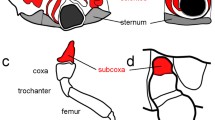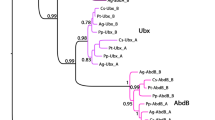Abstract
The leg genes extradenticle, homothorax, dachshund, and Distal-less define three antagonistic developmental domains in the legs, but not in the antenna, of Drosophila. Here we report the expression patterns of these leg genes in the prosomal appendages of the spider Cupiennius salei. The prosoma of the spider bears six pairs of appendages: a pair of cheliceres, a pair of pedipalps, and four pairs of walking legs. Three types of appendages thus can be distinguished in the spider. We show here that in the pedipalp, the leg-like second prosomal appendage, the patterns are very similar to those in the legs themselves, indicating the presence of three antagonistic developmental domains in both appendage types. In contrast, in the chelicera, the fang-like first prosomal appendage, the patterns are different and there is no evidence for antagonistic domains. Together with data from Drosophila this suggests that leg-shaped morphology of arthropod appendages requires an underlying set of antagonistic developmental domains, whereas other morphologies (e.g. antenna, chelicera) may result from the loss of such antagonistic domains.






Similar content being viewed by others
References
Abu-Shaar M, Mann RS (1998) Generation of multiple antagonistic domains along the proximodistal axis during Drosophila leg development. Development 125:3821–3830
Abzhanov A, Kaufman TC (2000) Homologs of Drosophila appendage genes in the patterning of arthropod limbs. Dev Biol 227:683–689
Abzhanov A, Holtzman S, Kaufman TC (2001) The Drosophila proboscis is specified by two Hox genes, proboscipedia and Sex combs reduced, via repression of leg and antennal appendage genes. Development 128:2803–2814
Affolter M, Marty T, Vigano MA (1999) Balancing import and export in development. Genes Dev 13:913–915
Beermann A, Jay DG, Beeman RW, Hülskamp M, Tautz D, Jürgens G (2001) The Short antennae gene of Tribolium is required for limb development and encodes the orthologue of the Drosophila Distal-less protein. Development 128:287–297
Chu J, Dong PDS, Panganiban G (2002) Limb type-specific regulation of bric a brac contributes to morphological diversity. Development 129:695–704
Cohen SM, Jürgens G (1989a) Proximal-distal pattern formation in Drosophila: cell autonomous requirement for Distal-less gene activity in limb development. EMBO J 8:2045–2055
Cohen SM, Jürgens G (1989b) Proximal-distal pattern formation in Drosophila: graded requirement for Distal-less gene activity during limb development. Roux’s Arch Dev Biol 198:157–169
Cohen SM, Brönner G, Küttner F, Jürgens G, Jäckle H (1989) Distal-less encodes a homeodomain protein required for limb development in Drosophila. Nature 338:432–434
Couso JP, Bishop SA (1998) Proximo-distal development in the legs of Drosophila. Int J Dev Biol 42:345–352
Cummins M, Pueyo JI, Greig SA, Couso JP (2003) Comparative analysis of leg and antenna development in wild-type and homeotic Drosophila melanogaster. Dev Genes Evol 213:319–327
Damen WGM, Tautz D (1998) A Hox class 3 orthologue from the spider Cupiennius salei is expressed in a Hox-gene-like fashion. Dev Genes Evol 208:586–590
Damen WGM, Hausdorf M, Seyfarth EA, Tautz D (1998) The expression pattern of Hox genes in the spider Cupiennius salei suggests a conserved mode of head segmentation in arthropods. Proc Natl Acad Sci USA 95:10665–10670
Dong PDS, Chu J, Panganiban G (2000) Coexpression of the homeobox genes Distal-less and homothorax determines Drosophila antennal identity. Development 127:209–216
Dong PDS, Chu J, Panganiban G (2001) Proximodistal domain specification and interactions in developing Drosophila appendages. Development 128:2365–2372
Dong PDS, Scholz Dicks J, Panganiban G (2002) Distal-less and homothorax regulate multiple targets to pattern the Drosophila antenna. Development 129:1967–1974
Gonzalez-Crespo S, Morata G (1995) Control of Drosophila adult pattern by extradenticle. Development 121:2117–2125
Gonzalez-Crespo S, Morata G (1996) Genetic evidence for the subdivision of the arthropod limb into coxopodite and telopodite. Development 122:3921–3928
Machida R (2000) Serial homology of the mandible and maxilla in the Jumping Bristletail Pedetontus unimaculatus Machida, based on external embryology (Hexapoda: Archaeognatha, Machilidae). J Morphol 245:19–28
Mardon G, Solomon NM, Rubin GM (1994) dachshund encodes a nuclear protein required for normal eye and leg development in Drosophila. Development 120:3473–3486
Mittmann B, Scholtz G (2001) Distal-less expression in embryos of Limulus polyphemus (Chelicerata, Xiphosura) and Lepisma saccharina (Insecta, Zygentoma) suggests a role in the development of mechanoreceptors, chemoreceptors, and the CNS. Dev Genes Evol 211:232–243
Mittmann B, Scholtz G (2003) Development of the nervous system in the “head” of Limulus polyphemus (Chelicerata: Xiphosura): morphological evidence for a correspondence between the segments of the chelicerae and of the (first) antennae of Mandibulata. Dev Genes Evol 213:9-17
Niwa N, Saitoh M, Ohuchi H, Yoshioka H, Noji S (1997) Correlation between Distal-less expression patterns and structures of appendages in development of the two-spotted cricket, Gryllus bimaculatus. Zool Sci 14:115–125
Panganiban G, Sebring A, Nagy L, Carroll SB (1995) The development of crustacean limbs and the evolution of arthropods. Science 270:1363–1366
Popadic A, Panganiban G, Rusch D, Shear WA, Kaufman T (1998) Molecular evidence for the gnathobasic derivation of arthropod mandibles and for the appendicular origin of the labrum and other structures. Dev Genes Evol 208:142–150
Prpic NM, Tautz D (2003) The expression of the proximodistal axis patterning genes Distal-less and dachshund in the appendages of Glomeris marginata (Myriapoda: Diplopoda) suggests a special role of these genes in patterning the head appendages. Dev Biol 260:97–112
Prpic NM, Wigand B, Damen WGM, Klingler M (2001) Expression of dachshund in wild-type and Distal-less mutant Tribolium corroborates serial homologies in insect appendages. Dev Genes Evol 211:467–477
Prpic NM, Janssen R, Wigand B, Klingler M, Damen WGM (2003) Gene expression in spider appendages reveals reversal of exd/hth spatial specificity, altered leg gap gene dynamics, and suggests divergent distal morphogen signaling. Dev Biol 264:119–140
Rauskolb C (2001) The establishment of segmentation in the Drosophila leg. Development 128:4511–4521
Rauskolb C, Smith KM, Peifer M, Wieschaus E (1995) extradenticle determines segmental identities throughout Drosophila development. Development 121:3663–3673
Rogers BT, Peterson MD, Kaufman TC (2002) The development and evolution of insect mouthparts as revealed by the expression patterns of gnathocephalic genes. Evol Dev 4:96–110
Scholtz G, Mittmann B, Gerberding M (1998) The pattern of Distal-less expression in the mouthparts of crustaceans, myriapods and insects: new evidence for a gnathobasic mandible and the common origin of Mandibulata. Int J Dev Biol 42:801–810
Schoppmeier M, Damen WGM (2001) Double-stranded RNA interference in the spider Cupiennius salei: the role of Distal-less is evolutionarily conserved in arthropod appendage formation. Dev Genes Evol 211:76–82
Sunkel CE, Whittle JRS (1987) Brista: a gene involved in the specification and differentiation of distal cephalic and thoracic structures in Drosophila melanogaster. Roux’s Arch Dev Biol 196:124–132
Tautz D, Pfeifle C (1989) A non-radioactive in situ hybridization method for the localization of specific RNAs in Drosophila embryos reveals translational control of the segmentation gene hunchback. Chromosoma 98:81–85
Telford MJ, Thomas RH (1998) Expression of homeobox genes shows chelicerate arthropods retain their deutocerebral segment. Proc Natl Acad Sci USA 95:10671–10675
Thomas RH, Telford MJ (1999) Appendage development in embryos of the oribatid mite Archegozetes longisetosus (Acari, Oribatei, Trhypochthoniidae). Acta Zool 80:193–200
Williams TA (1998) Distalless expression in crustaceans and the patterning of branched limbs. Dev Genes Evol 207:427–434
Williams TA, Nulsen C, Nagy LM (2002) A complex role for Distal-less in crustacean appendage development. Dev Biol 241:302–312
Wu J, Cohen SM (1999) Proximodistal axis formation in the Drosophila leg: subdivision into proximal and distal domains by Homothorax and Distal-less. Development 126:109–117
Acknowledgements
We thank Diethard Tautz for his continuous support and interest in our work. The work of W.G.M.D. has been funded by the European Commission, Brussels (Marie Curie Fellowship) and by the Deutsche Forschungsgemeinschaft (DFG; grant Da526/1-1 and Da526/1-2). The work of N.M.P. has been funded by the Deutsche Forschungsgemeinschaft (grant TA 99/19-1).
Author information
Authors and Affiliations
Corresponding author
Additional information
Edited by M. Akam
Rights and permissions
About this article
Cite this article
Prpic, NM., Damen, W.G.M. Expression patterns of leg genes in the mouthparts of the spider Cupiennius salei (Chelicerata: Arachnida). Dev Genes Evol 214, 296–302 (2004). https://doi.org/10.1007/s00427-004-0393-5
Received:
Accepted:
Published:
Issue Date:
DOI: https://doi.org/10.1007/s00427-004-0393-5




